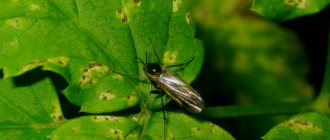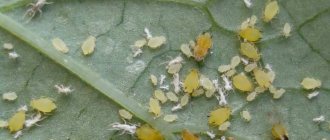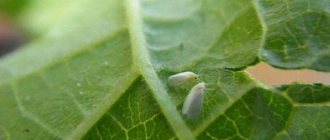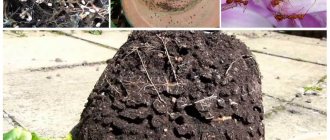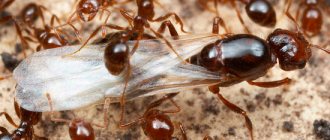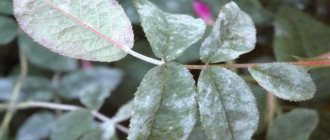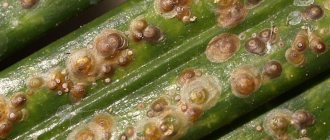Curling leaves, wilting buds, and the plant losing its attractiveness are the first signs of pests. To save the beauty on the windowsill, you need to know how to get rid of aphids on indoor flowers and prevent their appearance in the future. When fighting parasites, it is important to identify and eliminate the causes of the problem, and then destroy the pests using folk remedies or insecticides.
Aphids are a dangerous parasite that quickly adapts to any conditions and in a short time creates large colonies that destroy indoor plants. To save your home greenhouse, it is important to start pest control in a timely manner.
The article contains relevant and effective methods of combating aphids that will help save the plant and restore its attractiveness and vitality.
Description of aphids and how they appear in the house
Aphids are small insects with long legs and a pointed abdomen. The oblong body can be yellow, green, black or pink, but white pests are most often found on indoor plants.
One female aphid can lay up to 100 eggs at a time, which in a couple of weeks turn into adults that destroy flowers. Parasites use their proboscis to suck out the juice from the stems and leaves, depriving the plant of its vitality and attractiveness. In addition, they often spread viral and fungal diseases (sooty fungus). If the necessary measures are not taken in a timely manner, pests quickly adapt to any habitat and form numerous colonies that can destroy all the beauty on the windowsill.
Aphids attack different types of plants, but hyacinths, chrysanthemums, hibiscus, orchids, fuchsias and cyclamens are especially susceptible to attack by pests.
Where can pests appear in the house:
- through open windows and a balcony in the absence of mosquito nets;
- with new flowers (cut or in pots);
- from a person's clothing;
- through the soil used for transplantation;
- The carriers of the larvae can be ants that breed aphids for their own food.
To avoid the spread of aphids from a newly purchased plant to your home ones, keep it in quarantine for several days, and also carry out preventive treatment with special insecticides.
The main reason for the appearance of aphids is dried soil and high indoor temperatures.
Damage from aphids to indoor plants
Aphids, carrying out their activities, often cause irreparable damage to house plants, which consists of the following:
- Sucking all liquid masses from stems, leaves and buds , which leads to their dehydration, deformation, and in the most advanced situations, death.
- Falling buds or simply lack of flowering due to the fact that they do not bloom.
- Covering plants with a special sweet dew , which disrupts respiratory processes.
- General weakening of the plant , which makes it more susceptible to infection by various diseases and can lead to death.
- The spread of viral diseases and the promotion of various fungal formations.
- Deterioration of the external condition of the plant and disruption of its visual appeal.
Signs of pests on flowers
Aphids can cause significant damage to plants, so it is important to begin combating the parasites as early as possible. To do this, you need to know the signs of pests in your home greenhouse and periodically inspect each indoor flower for symptoms of disease.
The first manifestations of aphid infestation:
- a sticky layer and tiny punctures appear on the leaves and young shoots;
- flower buds quickly fade and fall off before they have time to bloom;
- the flower loses its attractiveness, withers and dries out;
- leaves darken and curl;
- Ants appear on the windowsill, attracted by the waste products of aphids, which are used by insects as food.
One of the signs of plant infestation by aphids is the appearance of ants. Insects feed on honeydew secreted by parasites, so they are always close to them and can even independently introduce pests to flowers
What plants do aphids attack?
The main danger of aphids is their omnivorous nature . These pests are most interested in roses, but can feed on virtually any houseplant. If you remove the species they were eating, the insects may switch to other plants that were not previously attacked.
Only pelargoniums, the smell of which they cannot tolerate, and palm trees have guaranteed protection from them, since the structure of their leaves is quite rigid. However, if measures are taken to destroy aphids, most individuals can migrate to plants that they do not eat for only one purpose: to wait out the danger there and return back to a favorable environment.
Folk remedies and methods of combating aphids
You can remove aphids from indoor plants yourself using available means. Such methods are easy to use, affordable and absolutely safe for healthy flora, people and pets.
Algorithm for saving indoor plants:
- Isolation of a sick flower, which will protect the rest from infection.
- Preventive spraying of healthy flora.
- Treatment of the affected flower using the chosen method.
Folk remedies for fighting aphids are presented in the table:
| Active substance | Procedure for preparing the composition | Mode of application |
| Celandine | Grind 150 g of dried raw materials or 350 g of fresh herbs and add 1 liter of water. Leave the product in the dark for 24 hours | Spray the plant with the resulting infusion three times at intervals of a day. |
| Wood ash | Mix 50 g of soap, 0.5 l of ash and 10 l of water | Treat the affected leaves and shoots with a filtered solution until the pests are completely destroyed. |
| Garlic | Grind 30 g of garlic in a blender, add 1 liter of water and leave to brew for a day in a dark place. | Treat the flowers with the resulting product three times at intervals of 5 days. |
| Tomato tops | Grind 500 g of raw material, add 1 liter of water and boil for 30 minutes. Add 4 g of liquid soap to the cooled broth | Treat the affected plant until complete recovery. |
| Tobacco | Combine raw materials and water in a 1:2 ratio and let it brew for 2 days. | Dilute the resulting infusion with water and spray the flower. Avoid contact with the soil to avoid damage to the root system. |
| Hot pepper | Grind 50 g of pepper and add 125 ml of water. Boil the mixture for an hour and let it brew for a day | Dilute the filtered infusion in 10 liters of water, use for spraying and watering flowers |
| Orange peels | Pour 100 g of citrus peel with water and let it brew for a couple of days in a warm place | Spray plants affected by aphids |
| Needles | Pour 500 g of pine needles into 2 liters of water and leave for a week, then strain and dilute with water in a ratio of 1:7 | Treat the flower several times with a break of 4 days |
Geranium, dill, parsley, mint or marigold will help fight aphids. Parasites cannot stand the aromas of these plants, so by placing a pot with one of them on the windowsill, you can not only get rid of pests, but also avoid their appearance in the future.
Ladybugs can be used as a biological method of controlling aphids, so do not drive out an insect that has settled on an indoor flower
House aphids - appearance and developmental features
Detecting this fragile, but dangerous and ruthless enemy is not difficult - aphids are clearly visible to the naked eye. Their usual sizes are from 0.5 to 2 mm. Winged females are larger, in some species they can reach 0.8 cm in length.
Aphids found on indoor flowers most often have a greenish or whitish color. But there are individuals colored dark - brown, or even reddish. The abdomen is swollen, visible in the sun, and often has two or several growths. Dark eyes and antennae are clearly visible. The legs of aphids are thin and translucent. Aphids cannot run and move slowly. Some types of aphids are capable of folding their legs in moments of danger and falling down to the ground.
Entomological classification of aphids
Currently, aphids, more precisely, True Aphids (lat. Aphidoidea), are included in the order Hemiptera (according to the outdated classification of aphids, they were classified as Homoptera). The order Hemiptera, or Proboscis, belongs to the phylum Arthropods, class Insects. Like all representatives of Proboscis, aphids have a piercing-sucking type of mouthparts. All types of aphids, without exception, are entomophagous and feed on plant juices.
Most often, ornamental plants are affected by the greenhouse aphid, also known as the house aphid, and less often by other insects from the family of grass aphids: peach aphid, nymphaean aphid, etc.
Attack of the Clones and Winged Mission
Aphids can reproduce asexually, which means they can actually clone themselves. The scientific name for this phenomenon is parthenogenesis.
But every few generations, a colony of aphids gives rise to a swarm of winged females, and with them, male aphids. The task of this generation is mating and the spread of aphid colonies to neighboring plants. A winged flock of fertilized females is carried by the wind far beyond the boundaries of the native population. There they look for plants suitable for feeding, and then go down to their roots and lay eggs for the winter. Clutches of parasites can be located both on the trunk of the host plant and in the soil, near its roots.
Population explosion as a way of resistance
The emergence of the winged generation of aphids can be provoked not only by the approach of autumn cold weather. Flying females appear at the moment when food begins to dry up. Or - if the colony is attacked by numerous enemies.
When attacked, for example, by lacewing larvae, aphids do not even try to escape. Although they have a clear advantage - the predatory larva is blind from birth, and searches for its prey at random, rushing from side to side. It is easy for sighted aphids to dodge its jaws, but... they continue to suck the juices of the plant, not paying attention to the danger. And the predator larva crawls along the leaf like a real killing machine, leaving behind only the empty skins of its victims.
But after some time, a real demographic explosion occurs in the devastated population. Each female produces four to five times as many aphid clones. Along with the wingless ones, winged individuals also appear, which fly around the surrounding area in search of quieter places. Aphids respond to danger with an explosive increase in numbers. This is her way of resistance.
Mechanical methods of getting rid of pests
You can save indoor flowers using mechanical cleaning, but this method is effective only at the initial stage of infection. To preserve the plant, remove damaged leaves, buds and shoots and wash it daily under running water. A solution of laundry soap will help to achieve maximum effect. Processing procedure:
- Prepare a soap solution from laundry soap and water in a ratio of 1:6.
- Prepare the necessary attributes, put on rubber gloves.
- Soak a sponge in the solution and thoroughly wipe all leaves, shoots and stems. Avoid getting the product on the soil.
- Rinse the plant with clean running water.
- Repeat the treatment daily until the parasites are completely eliminated.
To mechanically remove aphids, wipe the leaves daily with a damp sponge, remove affected shoots and bathe the flowers under running water.
As an alternative to soap solution, you can use medical alcohol - dissolve 6 tbsp in 1 liter of water. spoons of the product and wipe all the leaves. This composition effectively removes pests and does not damage the leaves, since ammonia quickly evaporates from the surface.
To be sure to get rid of aphids, replace the top part of the soil, where eggs and larvae of pests may be. In this case, choose high-quality soil that has been disinfected or frozen.
Chemicals for killing parasites
If folk remedies are ineffective, use chemicals. The choice of means depends on the degree of damage and the scale of the disaster. The most effective means include: “Decis”, “Iskra”, “Fitoverm”, “Aktellik”, “Confidor”, “Akarin”, “Karate”.
Spraying flowers with chemicals will help get rid of aphids. When working with insecticides, observe safety precautions and strictly follow the instructions for the product.
Procedure for using chemicals:
- Read the instructions for use of the product.
- Take the recommended safety measures - put on seals and a respirator, remove pets and children from the premises. After handling, wash your hands thoroughly with a concentrated soap solution.
- Wipe the leaves and stems with a sponge soaked in soapy water and then let dry.
- Spray the flower. Carry out the treatment on the balcony on a cloudy day at a temperature of +21…25 ℃, since at a lower temperature the effectiveness of the drug decreases.
- Perform preventive spraying of all plants in the house to prevent aphids from moving onto them.
- Re-treat the flowers several times at intervals of 5-7 days (depending on the recommendations in the instructions).
If the plant cannot be saved, discard it to avoid contaminating other flowers.
Prevention of aphids
Proper plant care and compliance with the recommended preventive measures will help to avoid the appearance of aphids:
- periodically carry out preventive treatment of plants;
- Make sure to maintain the optimal temperature in the house, as insects settle in a stuffy, poorly ventilated room;
- keep new flowers in quarantine;
- install mosquito nets on all windows in the apartment;
- do not place bouquets of cut flowers (especially chrysanthemums and roses) near indoor plants;
- Soak the new soil for replanting in the cold for several days to destroy the larvae and eggs of pests.
To preserve indoor flowers, provide them with proper care, regularly inspect them to identify pests in a timely manner, and periodically carry out preventive treatment
Maintaining a favorable microclimate in the house, proper care of plants and compliance with preventive measures will help save indoor flowers from aphids. If you were unable to protect them from pests, start fighting when parasites are first detected, preventing the colony from growing. Mechanical treatment, folk remedies and chemicals can help in exterminating insects. The choice of control method depends on the scale of the disaster and individual preferences.
Signs of defeat
The initial check-in goes smoothly. In the initial stages, aphids are found on the lower surface of leaves. Then the pests move on to the shoots, buds, cuttings, and the upper side of the leaves. If at least one insect is detected, inspection should be carried out regularly.
On the petals of the buds you can see oblong eggs. White aphids on plants, when the colony multiplies unhindered, can cover the entire crop in 10-14 days.
Typical manifestations of infection:
- Yellowing of leaves, rapid wilting, curling, sticking and drying;
- The appearance of chlorotic spots;
- Weakening of the plant, loss of an attractive, healthy appearance;
- Damage to apical shoots;
- Flowers and inflorescences are crushed and deformed;
- Detection of traces of tiny punctures;
- The appearance of a sticky sugary liquid in infected areas;
- The affected parts become black and sticky;
- Attachment of a fungal infection.
White and black aphids are found on indoor chrysanthemums. Parasites hide in unopened buds and are difficult to see in the early stages. The main signs of damage at its height are deformation, drying out, blackening of shoots, leaves, and inflorescences.
